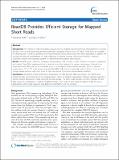| dc.contributor.author | Rolfe, Philip Alexander | |
| dc.contributor.author | Gifford, David K. | |
| dc.date.accessioned | 2011-08-19T14:58:51Z | |
| dc.date.available | 2011-08-19T14:58:51Z | |
| dc.date.issued | 2011-07 | |
| dc.date.submitted | 2010-11 | |
| dc.identifier.issn | 1471-2105 | |
| dc.identifier.uri | http://hdl.handle.net/1721.1/65339 | |
| dc.description.abstract | Background: The advent of high-throughput sequencing has enabled sequencing based measurements of cellular function, with an individual measurement potentially consisting of more than 108 reads. While tools are available for aligning sets of reads to genomes and interpreting the results, fewer tools have been developed to address the storage and retrieval requirements of large collections of aligned datasets. We present ReadDB, a network accessible column store database system for aligned high-throughput read datasets. Results: ReadDB stores collections of aligned read positions and provides a client interface to support visualization and analysis. ReadDB is implemented as a network server that responds to queries on genomic intervals in an experiment with either the set of contained reads or a histogram based interval summary. Tests on datasets ranging from 105 to 108 reads demonstrate that ReadDB performance is generally within a factor of two of local-storage based methods and often three to five times better than other network-based methods. Conclusions: ReadDB is a high-performance foundation for ChIP-Seq and RNA-Seq analysis. The client-server model provides convenient access to compute cluster nodes or desktop visualization software without requiring a shared network filesystem or large amounts of local storage. The client code provides a simple interface for fast data access to visualization or analysis. ReadDB provides a new way to store genome-aligned reads for use in applications where read sequence and alignment mismatches are not needed. | en_US |
| dc.description.sponsorship | National Institutes of Health (U.S.) (grant 5TL1EB008540) | en_US |
| dc.description.sponsorship | National Institutes of Health (U.S.) (grant 5R01HG002668) | en_US |
| dc.description.sponsorship | National Institutes of Health (U.S.) (grant P01-NS055923-01) | en_US |
| dc.description.sponsorship | National Institutes of Health (U.S.) (grant 1-UL1-RR024920) | en_US |
| dc.publisher | BioMed Central Ltd | en_US |
| dc.relation.isversionof | http://dx.doi.org/10.1186/1471-2105-12-278 | en_US |
| dc.rights | Creative Commons Attribution | en_US |
| dc.rights.uri | http://creativecommons.org/licenses/by/2.0 | en_US |
| dc.source | BioMed Central Ltd | en_US |
| dc.title | ReadDB Provides Efficient Storage for Mapped Short Reads | en_US |
| dc.type | Article | en_US |
| dc.identifier.citation | BMC Bioinformatics. 2011 Jul 07;12(1):278 | en_US |
| dc.contributor.department | Massachusetts Institute of Technology. Computer Science and Artificial Intelligence Laboratory | en_US |
| dc.contributor.mitauthor | Rolfe, Philip Alexander | |
| dc.contributor.mitauthor | Gifford, David K. | |
| dc.relation.journal | BMC Bioinformatics | en_US |
| dc.eprint.version | Final published version | en_US |
| dc.identifier.pmid | 21736741 | |
| dc.type.uri | http://purl.org/eprint/type/JournalArticle | en_US |
| eprint.status | http://purl.org/eprint/status/PeerReviewed | en_US |
| dc.date.updated | 2011-07-25T16:01:45Z | |
| dc.language.rfc3066 | en | |
| dc.rights.holder | Rolfe et al.; licensee BioMed Central Ltd. | |
| dspace.orderedauthors | Rolfe, P Alexander; Gifford, David K | en |
| dc.identifier.orcid | https://orcid.org/0000-0003-1709-4034 | |
| mit.license | PUBLISHER_CC | en_US |
| mit.metadata.status | Complete | |
